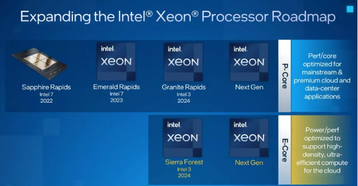At its annual Investor Day show, Intel detailed its server chip roadmap.
The company said it has now split its data center processors into two lanes - P-Core (Performance Core) which are focused on the best possible performance, and E-Core (Efficiency Core), which are optimized for energy efficient workloads in the cloud.
Intel 3 processors (which other companies would call 5nm) are progressing better than expected, with the company moving the product a year earlier from 2025.
2024's Granite Rapids Xeon SP v6 CPU will now be on Intel 3. A 'P-Core' chip, it will follow the 56 core-Sapphire Rapids (2022) and Emerald Rapids, which are both Intel 7 (otherwise known as 10nm). That means the company has skipped the Intel 4 process, which would traditionally be called 7nm.
Over on the E-Core line, Intel plans to launch an Intel 3 'Sierra Forrest' CPU in 2024. It plans follow-up processors, but gave no further details. The company said the product was developed at the request of hyperscale cloud companies.
It envisions P-Core chips to serve workloads like AI, HPC, and databases. E-Core, meanwhile, will be best for highly-parallel latency-tolerant workloads, like high-density VM deployments, data analytics, and front-end web services. It does not plan to make chips featuring both types of core.
The company also teased the 'Arctic Sound-M' platform, which includes a DG2 GPU (also known as Intel Alchemist). The data center GPU is currently sampling, and will be available in mid-2022. It pitched the system as for the media encoding and analytics market, as the first server accelerator with hardware AV1 video encoding.
Intel said that it was finally on track to deliver Ponte Vecchio GPUs for the Aurora supercomputer later this year. After years of delays, the supercomputer is expected to be the world's most powerful once it launches.
Finally, Intel announced the Falcon Shores XPU - a combination of x86 and the Xe GPU hardware on a single Xeon socket chip. Few details were shared about the project, which is targeted at supercomputing workloads. It is targeted for around 2024.




